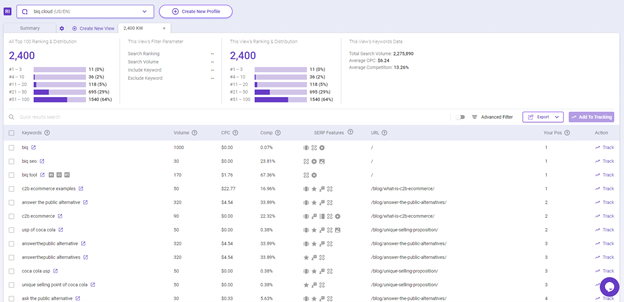Discover 9 effective brainstorm techniques you can use to write quality blog posts and take your content creation to the next level.
Here are the 9 effective brainstorm techniques you can use to bring your blogging and content creation to the next level.
53% (more than half) of businesses spend their time and money on content marketing, and 51% of the companies that invest in content marketing publish content every day.
Blog posts (69%), videos (72%), and original data (60%, i.e., customer showcases, infographics, research, etc.) are the three most popular types of content. This is according to The Manifest content marketing report.
But not all the content out there is helpful to the readers. A research study of over 300 large companies shows that less than one-third (approximately 31%) had quality site content – based on content clarity, voice, tone, spelling, and grammar.
This shows that creating high-quality content can be challenging but not impossible. Most successful bloggers and content marketers leverage some set of brainstorming techniques to guide them to generate quality and engaging content ideas.
We’ve rounded up the 9 best brainstorming techniques you can borrow to implement in your content creation and marketing journey.
9 Best Brainstorming Techniques
Every content writer, at some point, will need some brainstorming techniques to fire up their creativity. The process may sound complicated, but it doesn’t have to be.
If you’re familiar with the popular brainstorming techniques such as mind mapping and 6-3-5 brainwriting – common among creatives – then you’ll realize that generating content ideas for your posts is a lot easier since there are tools to guide you through.
The brainstorming techniques we’ve picked are a lot user-friendly and don’t require a heavy thought-process.
We’ve accompanied each brainstorming technique with a BiQ use case example to give you a practical touch on the best content creation and brainstorming strategies.
Below are the 9 brainstorming techniques you can use right away:
1. Check your ranking keywords
Tracking your ranking keywords isn’t only an SEO best practice but also one of the best brainstorming techniques to give you vital insights about your domain performance.
Once you know what phrases people use to find your products or services, you can play around with those words to draft content ideas that will further expand your online visibility.
Your valuable and top-performing keywords are your assets. Ensure the posts you are creating around those phrases are quality enough not to hurt your SEO ranking.
Tip:
Use our BiQ’s Rank Intelligence to identify the keywords you are already ranking for.

Once you enter your website URL into the Rank Intelligence and select the country your audience is based, you’ll get some critical insights and data about your site.

From here, you can also get a close look into each ranking keyword’s metrics, including the search volume, competition, cost-per-click, and more.
Using these insights, you can see which keywords perform well and have higher popularity than the rest. Then, you use them to brainstorm for more content ideas by expanding the topics.
For example, if many people are searching for a “beginner guide to blogging” on your website, you can expand the topic to writing about blogging tips, blogging tools, and so on.
2. Keyword research
SEO keywords are a vital part of your content. They determine whether your posts will pop up on the search engines when people type some phrases and click the search button. This alone makes keyword research one of the most valuable brainstorming techniques.
When brainstorming ideas to cover in your content, keyword research will help you answer the audience’s questions based on what they are searching across the internet.
For example, if the phrase “content marketing” has a higher search volume and you are writing on “best digital marketing techniques,”: you’ll be keen to prioritize topics on content marketing before others such as email marketing, Pay per click, social media marketing, etc.
Tip:
Use our BiQ’s Keyword Intelligence as one of your brainstorming techniques to find new keywords related to your top-performing search queries or phrases.
All you need to do is enter your main keyword in the search bar and hit enter. What you’ll get is a list of related keywords with some valuable data such as the search volume (how many times people have searched the phrase), trends, and the cost per click (CPC).

The keyword intent and value are the other two metrics that tell you why your audience is searching those particular words (i.e., informational, transactional, or navigations) and how helpful those phrases are, based on their perceived value.

The keyword has an informational intent from the example above, which means the searchers are in the awareness stages.
Since the searchers are looking for more information, you can create informational content such as ‘why do you need content marketing?’ and ‘top content marketing examples’.
Scroll down and you’ll be able to identify each keyword intent so that you can understand your target audience better.
That is a great help because it eliminates assumptions and guesswork to identify the searchers’ intent.
Unlike the other brainstorming techniques, researching the keyword gives you lots of valuable resources that you can use to target and reach the audience better.
3. List out questions people ask
Questions are crucial when brainstorming an idea or topics to include in your content. The questions that people enter into the search engines will help you create content relevant to the audience. It guides you on the topics to cover so you can address the prospects’ unmet needs.
Just like you’ll do when brainstorming for writing a creative piece, you want to exhaust your audience’s key concerns then map out the pain points.
You can then narrow down to how you can leverage these problems to craft unique content that offers helpful answers and instant solutions.
Tip:
Use our BiQ’s Keyword Intelligence to find popular questions people are searching across the internet.

To use this tool, type in the keyword phrase and once you hit enter, navigate to the Popular Questions tab. You’ll see a list of questions that people are frequently searching for.
Not all the search queries will be relevant for your audience. You need to compile those questions related to the topic you want to cover. This is one of the brainstorming techniques that give you the finer details of what the audience is looking for.
4. Do competitor analysis
Competitor analysis, commonly referred to as SEO competitor analysis, is one of the brainstorming techniques that allow you to see your audience and the target market from the competitors’ perspective.
Like keyword research, this is another example of brainstorming techniques where you borrow some great content ideas from your competitors based on the keywords they are ranking for.
Here you’ll find exclusive information about your competitors’ best practices, mistakes, and most importantly, their competitive advantages. Below are the other benefits of incorporating competitor analysis to your content brainstorming techniques:
- Some of the insights you’ll get will help you better understand your audience.
- You’ll learn new and valuable strategies.
- You’ll find new keywords that will help you find new audiences.
Tip:
Here you can use our BiQ’s Rank Intelligence as one of the brainstorming techniques to discover the competitors’ top-performing keywords and use them to generate your blog post ideas.
Just enter your competitor’s domain in the Rank Intelligence, and you will quickly see their top-performing keywords and content:

Competitor analysis is a simple brainstorming technique that will help you map out the competitors’ best-performing content. You’ll then dig deep into their content writing style, check their structuring, flow, and delivery.
5. Use a content ideas generator
If you are looking to brainstorming Ideas the smart way, using a content ideas generator is the way to go. Here, you’ll generate engaging topics that add value to the audience.
Now more than ever, businesses want to know more about their prospects and customers. To target them better, they need to go above and beyond to generate custom content.
Businesses are also striving to create quality content that directly answers the audience’s questions and those that instantly solves their problems. This is probably one of the reasons why content brainstorming techniques are increasingly becoming popular.
Tip:
Use our BiQ’s Keyword Intelligence to generate content ideas that will help you craft high-quality, educative, and engaging posts.
Enter the keywords, and this tool will generate a list of content ideas. Sort through them to see what resonates well with your audience.
6. Use Google Search Operator
It’s interesting to learn that there’s a way you can configure the search engines to give you more accurate results.
Google search operators are some great brainstorming techniques where you use words or symbols with your keywords/search phrases to get more precise results.
For example:
- Use quotation marks to find exact matches – If you search the word “video content marketing” with the quotation marks, you’ll get more accurate results than when you search without the quotation marks.
Search results without the quotation marks
Using quotation marks gives you more accurate results.
- Use the site operator (“site:”) to dig into any domain and get related blog ideas – for example, to check all the marketing posts or pages that Google has indexed from BiQ Cloud:
Search: site: Biq.cloud marketing, and the results will be as shown in the screenshot below.

The use of Google search operators is one of the less-known and underutilized brainstorming techniques. Tapping into this ingenious brainstorming solution will help you do more research and develop great content ideas.
7. Ask your readers what they want
If you’re almost exhausting all the brainstorming techniques, but you can’t seem to get brilliant ideas, asking your readers what they want could be your best bet. This isn’t to say this should be your last resort; in fact, it should be one of your favorite content brainstorming techniques.
Your social media accounts are the best channels to engage your audience and get them to give you the answers you want.
For example, create a poll on social media such as Twitter or Facebook asking your audience what their preferences are – e.g., what type of content they would prefer among infographics, blog posts, listicles, etc.
You can also target your audience directly by sending them a survey via email and rewarding them for responding to your survey – say, give them a 10% discount on their next store purchase, etc.
Engaging your audience is one of the game-changing brainstorming techniques since you’re asking your prospects exactly what they want instead of relying on some assumptions and guesswork.
Here is an example of poll in Twitter:

8. Dive into social networks
Your social media networks are a great resource if you’re looking for content ideas that will engage and add value to your audience.
Researching your social networks isn’t only one of the best brainstorming techniques but also a content planning best practice that will give you more insights about your audience or prospects.
Emarsys 2019, social media predictions revealed that approximately 3.2 billion people use social media every day. This equates to about 42% of the world’s population – logging in, perusing, and conversing with friends on the various social media channels.
Already there are many content ideas you can tap from your social media accounts (Facebook, LinkedIn, Twitter, etc.) – without factoring in your audience’s posts, likes, conversations, shares, etc.
Tip:
Social media networks could be an excellent technique for brainstorming trending content ideas you want to drive engagement.
For example, a trending topic like “Tik-Tok Ban” could help you generate engaging topics that your audience will be interested in – e.g., the Importance of data privacy or Why localized marketing works, etc.
9. Go to the communities
Social communities such as Quora and subreddits often have a backlog of questions that can help you better understand your audience.
Analyzing the topics discussed in these social communities is one of the best brainstorming activities you can pick to inspire your creativity.
Of all the brainstorming techniques out there, going through social groups gives you an authentic feel of what your audience is really into. However, these groups should relate to your niche; otherwise, you’ll be compiling the wrong data.
For Example:
You can follow up a subreddit discussion on the latest Google ranking factors, and you’ll learn a lot from people who have tried a majority of the techniques recommended by SEO experts.

If you were covering content on “How to rank high on Google” and you are to limit your techniques to only 10 out of the 200, then you’ll know what to prioritize on your post.
Suppose you’re not leveraging social groups to source content ideas yet, you’re probably missing out. Be sure to incorporate this vital resource into your brainstorming techniques, and you’ll benefit from unique, first-hand ideas from your audience and even niche experts.
Extra tip: Identity What’s Important To Cover About Your Topic
Assuming that you have a great keyword in hand, you need to know what goes inside your content. The typical practice for a content writer to do this is to hop over to Google, type the keyword in, and open a dozen tabs consisting of the top articles.
The problem is it takes so long and human observation is prone to error. This is where BiQ’s Content Intelligence comes in handy. For any keyword of the document created, the tool analyzes it with the top-performing organic content on Google.

Better still, it gives you a breakdown of your keyword in terms of usage, similar keywords, and example sentences.

They should be the go-to-source that shapes your article as you write. For example, if you’re writing about “unrealistic standards”, just by running a Wordscope analysis can get you similar keywords like media standards trust, what is media ethics, and so on.
In other words, you can’t hope to satisfy searchers who are looking for unrealistic standards without writing about these similar keywords.
You can also make use of the keywords to craft your outline! That’s an example of killing two birds with one stone effectively.
Here are 9 SEO copywriting tips you can use to make great content.
Conclusion
All the above brainstorming techniques will give you a competitive edge in the content creation market. The brainstorming examples we’ve highlighted above will also guide you as you put the various brainstorming techniques into practice.
To make sure you are not misusing the above brainstorming techniques, always keep your content as original as possible. You don’t want to get lost in the creative process and end up copying everything. Otherwise, Google will flag your site for duplicate content.
Remember, not all the techniques of brainstorming content and blog post ideas will work for your unique case. Instead, you want to try each of the 9 brainstorming techniques, check what works, and incorporate them into your content creation and marketing strategy.
Any you using any other brainstorm techniques that are not mentioned above? Let me know in the comments.




